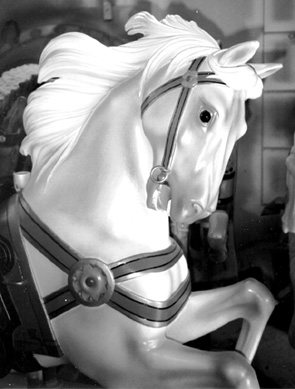



There's Still Magic in Those Old "Machines"
Their 'golden age' has come and gone, but there are merry rounds still to be had.
Here's where to find them.
by M.L. Faunce
![]() n many a weekday, my brisk noontime
walk on the Mall in Washington takes me back in time to a simpler period
- at least in my life - of simpler pleasures. A block or so up from the
high-tech world of the Air and Space Museum, on the lawn of the Castle of
the Smithsonian Institution, in good weather and bad, with or without joyful
riders, the carousel whirls on.
n many a weekday, my brisk noontime
walk on the Mall in Washington takes me back in time to a simpler period
- at least in my life - of simpler pleasures. A block or so up from the
high-tech world of the Air and Space Museum, on the lawn of the Castle of
the Smithsonian Institution, in good weather and bad, with or without joyful
riders, the carousel whirls on.
My father called such wonders flying horses. Merry-go-round was the name we used growing up. A century before, wood carvers like the famous Gustaf Dentzel created fanciful horses and a menagerie of animals set on a platform with a center pole with attached cables, calling them simply "machines."
From the turn of the century to well into the 1950s and 1960s, these magic machines were the main attraction at the favorite playgrounds of middle class families, amusement parks like Chesapeake Beach Park and Montgomery County's Glen Echo Park. Many in the Washington area, like my family, have strong memories of both parks.
Most are gone now, and families have their fun at theme parks that make the amusement parks of my youth seem quaint and innocent. Chesapeake Beach Park locked its gates in 1972. But Glen Echo Park and its carousel live on, joyful relics of an earlier age.
When I recently learned that the National Park Service was seeking proposals for the commercial development of Glen Echo Park, I felt a twinge of nostalgia for the thriving "trolley park," the dazzling amusement rides and the exotically named Spanish Ballroom that drew the crowds. But most of all, for the carousel that captured our hearts.
Some 40 miles distant from each other, the carousels at Chesapeake Beach Park and Glen Echo Park had a special connection.
Each park had two carousels in its history, and both surviving carousels were created by master carver Gustaf Dentzel. Both parks were connected to the city of Washington by rail line - the street car to Glen Echo and the Chesapeake Beach Railway to the Bay. Both had ballrooms that echoed with the big band sounds of Tommy and Jimmy Dorsey and Woody Herman. Each had a swimming pool: the unusual salt water pool overlooking the Bay at Chesapeake Beach and the famous "Crystal Pool" at Glen Echo, with a fountain and slides and its own quarter-acre sand beach.
The struggle for civil rights would overlap for both parks as well. The challenge of integration would close the gates to Glen Echo Park in 1968 (to reopen later under the federal National Park Service). Privately owned Chesapeake Beach Park would close for good in 1972.
But until those modern times, the old carousels turned many a happy round.
![]()
Mildred Finlon, 88, at right, remembers lying in her bed at night listening
to the carousel music drifting over Chesapeake Bay.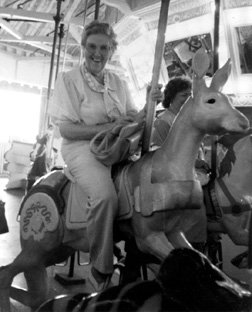
Finlon came to Chesapeake Beach in 1922, when her father, a railroad dining car steward, bought property and eventually built six small cottages on nearby 15th Street. In those days, the carousel stood on a pier over the water.
That carousel was Chesapeake Beach's first, built by Gustav Dentzel himself in 1899, the golden age of carousels. Signing the contract for Dentzel's work was the visionary Otto Mears, who had paved the way to the Bay and its pleasures with his shortline railroad in 1900.
Fire destroyed that carousel in late 1926. "Carousel horses were thrown overboard," Finlon remembers, "and could be seen floating in the Bay."
Harriet Stout, the curator of the Chesapeake Beach Railroad Museum says second-hand legend confirms Finlon's first-hand recollection. According to the stories she's heard, for a few years after the fire the charred remains of the old carousel could be seen sticking out of the muck of the Bay.
Storms in the 1930s damaged the mile-long boardwalk and resort amusement rides built over the water, and the Depression led to the financial collapse of the railroad.
A new park named Seaside was later built on land. After the park was bought by new owners around 1929, another carousel of "mostly" Dentzel figures would be installed. It was housed in a building constructed just for it, placed on a hill overlooking the beach where with the ride came cooling, brackish breezes from the Bay.
It's that menagerie of carousel figures that several new generations - my own among them - would come to know and love at Chesapeake Beach.
During World War II, gas rationing did in the new park. In the war years, Finlon and her husband Harold lived in Washington, where she was a teacher and Harold worked for the Navy Department. They returned full time to Chesapeake Beach, Mildred's childhood home, in 1947. She taught school, becoming supervisor of Calvert County Schools.
When the park was revitalized again by new owners Wesley Stinnett, Joe O'Mara and the Cate Brothers of Baltimore after World War II, they found their manager in Mildred Finlon's husband, Harold.
Harold Finlon was born into a Pennsylvania amusement park family. He grew up at Glen Echo, where his father had taken a job designing the merry-go-round building and managing the park. In 1948, long after his boyhood days at Glen Echo, Finlon jumped from his job with the Navy Department to become superintendent of Chesapeake Beach Park - thus forging another link between the two distant parks.
Sharing management with Finlon was Stinnett's son-in-law Freddie Donovan, who had been a policeman in Washington. They made a "beautiful pair of managers," Finlon says, what with Harold's mechanical abilities and Freddie's law and business abilities.
"Harold could work on anything mechanical in the park - the pool, the rides, the slot machines - but the carousel and band organ were his first love," Finlon says of her husband. "No matter where he was in the park, he'd be subconsciously listening to the music of the carousel and would run back when the old Wurlitzter would miss a beat."
![]()
In the days when the carousels turned, everybody had a favorite. For Gail Donovan Harkin, now of the Eastern Shore, it was the buffalo. "I still miss it," she said in an oral history with the Railway Museum at Chesapeake Beach. "You could never get enough of it."
Memorized by the generations as they picked  and chose their favorites, the rings of animals went something
like this: the inner-most ring held the most unusual: a seahorse with its
curling mermaid-like fish tail and two front hooves; the buffalo; an ostrich;
a goat; and a burro. The outside "standing" horses were stationary
sentinels going round and round but never up and down. That was reserved
for the lively inside ring: the jumping kangaroo, prancing, star gazing
horses and a menagerie of other creatures.
and chose their favorites, the rings of animals went something
like this: the inner-most ring held the most unusual: a seahorse with its
curling mermaid-like fish tail and two front hooves; the buffalo; an ostrich;
a goat; and a burro. The outside "standing" horses were stationary
sentinels going round and round but never up and down. That was reserved
for the lively inside ring: the jumping kangaroo, prancing, star gazing
horses and a menagerie of other creatures.
The kangaroo, said to have been carved by Dentzel himself, was Mildred Finlon's favored animal.
Actually, there were two kangaroos on the Chesapeake Carousel, which is how Mildred Finlon got plenty of time with her favorite. "Often Harold would bring one or the other home to repair the hinges in the legs," she remembers.
One of the kangaroos hung in her basement for nearly 25 years until the Chesapeake Beach Railway Museum was created. Faithfully and skillfully restored by Gary Jameson of North Beach, that kangaroo is now displayed at the Museum as one of the few tangible reminders of the beloved carousel that was sold in 1972. The second kangaroo still hops happily on the Chesapeake Carousel at its new home in Largo.
Today, they may be the only two surviving menagerie figures of their kind.
![]()
Steve Crescenze, an industrial arts teacher at John Hansen Middle School in Waldorf, is a man after Harold Finlon's heart. This self-taught artist brings history back to life as he restores the antique carousel figures. He's restored over 150, including the buffalo Gail Donovan rode as a youngster at Chesapeake Beach.
"The buffalo is extremely rare," says Crescenze. "It may
be the only buffalo made by the Dentzel Company." He's also restored
a Dentzel goat for the carousel, and when I visited his workshop he was
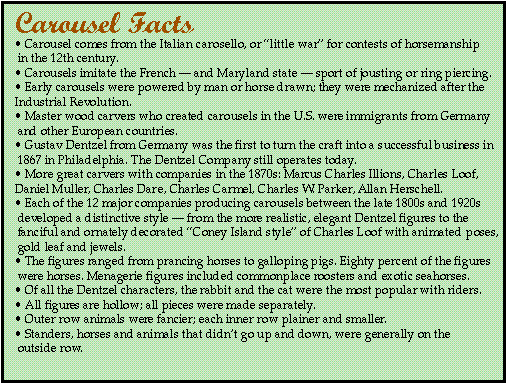 restoring a Dentzel-Muller horse - a "stander"
with a double eagle on the back of the saddle - as well as working on a
small brown "inner row horse."
restoring a Dentzel-Muller horse - a "stander"
with a double eagle on the back of the saddle - as well as working on a
small brown "inner row horse."
Crescenze doesn't have to ride carousel animals to get his kicks. Just getting up close and personal with these treasures - restoring standing horses, the celebrated buffalo or a beloved lion that resides in his home - seems to be reward enough.
Preparing the figures for restoration is exacting work Crescenze executes with caring hands. First, he strips away a small area to find the original colors. Then he strips the figure down to bare wood, which he repaints in bright original hues. Finally, he adds the "trappings" - decorative details and finish work prominent on the figures that stood on the carousels' outside row but left off the unseen inside of figures.
Examining a finished product, Crescenze proclaims himself "thrilled to work on pieces other craftsmen worked on so long ago and that will live on because they're being restored now."
He once found a message inside a lion's head. The artist had written his name and a few notes on the animal's construction and materials used.
"So now," Crescenze says, "I put in my own information and what I know about the origins. It's like a time capsule."
A capsule of that sort is precisely what Crescenze's house looks like. The man who used to restore old automobiles now lives with a menagerie that is part museum, part peaceable kingdom. On permanent display or in temporary residence for repair, at any given time you might find fantastic star-gazing horses, a massive lion, a clever cat with a fish in its mouth (facing in so as not to offend), an entire wall of carousel figures and painted rounding boards of pastoral scenes that were used with mirrors and light to decorate the carousel.
Crescenze has restored over 150 antique carousel figures, many from the Chesapeake Carousel.
"I love the painting - even the scraping is interesting - it's so exciting to see what you can find in the details covered up so long ago in so many layers of paint. There's so much art and history to this, it gives you chills," the craftsman says.
At the foot of Crescenze's bed stands a large park-size carousel horse he attributes to Charles Carmel, in the style of Charles Look, both famous woodcarvers. Decorated in the N.Y. Coney Island style and faithfully restored by Crescenze, it's in the right room for a dream ride.
![]()
The Chesapeake carousel rides on. Twenty-five miles from its original
home on the Bay, it still brings magic to visitors at Watkins Regional Park
in nearby Largo, Maryland. The debut at its new home in 1977 was made all
the more welcome by panels depicting scenes of Prince George's county history,
designed and painted by the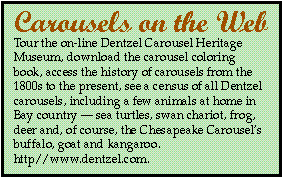 Laurel Art Guild.
Restoration of the carousel figures, begun by Rosa Ragan, continues by Steve
Crescenze.
Laurel Art Guild.
Restoration of the carousel figures, begun by Rosa Ragan, continues by Steve
Crescenze.
Last fall, I visited the park to take a ride on Gail Harkin's buffalo and met Mark Wakefield, 18, of Bowie, who was finishing up his second season as a carousel operator at Watkins Park. Operating the carousel "has been a lot of fun," Wakefield said. "You get to work with all different kinds of people; it's a good experience to work with kids, and it's nice to be outdoors."
When Steve Crescenze came to pick up two figures for restoration, Wakefield got a history lesson. He learned about the master carvers who had made these magnificent carousel figures. Of course Wakefield already knew their value: he could see that in the children's face as he rang the bell to signal the generous ride he gives.
Wakefield wasn't sure he'd be back in the summer of '98 to operate the carousel. Maybe that's why he so intently watched the figures go by - the seahorse, buffalo, ostrich, goat and burro. The unique kangaroo is working just fine, the rear-action hinged feet smoothly creating a jumping action.
As Wakefield began a new chapter of his life as a freshman at the University of Maryland, majoring in music education, no doubt a few tunes - like "Puff the Magic Dragon" and the Michigan fight song that he's heard over and over for two summers as the carousel whirled on - ran around in his head. Those and the "giggles and laughter of the kids."
![]()
Managers and operators still have to be able to work on all the mechanics of the carousel, Diane Baker, a manager at the park, told me. "We have to be a jack of all trades," she said. With all the other operators at Watkins Park, Wakefield had to learn all about the carousel, the lights, the gears and the music - nowadays from three tapes played over and over.
Harold Finlon would have liked knowing that the people now caring for the old Chesapeake carousel still listen, no matter where they are in the park, for the carousel's voice.
The beloved Wurlitzer band organ that was once a part of the magic that drifted over the Chesapeake Bay has disappeared, no one knows where. But the carousel itself is well cared for.
"On Mondays, the ride is closed and each carousel figure is washed, with water, not soap," Wakefield explained. Slowly washing the figures seems a good way to appreciate the beauty and the history until they almost come alive.
Through two world wars and an intervening depression, the carousels at Chesapeake Beach Park and Glen Echo Park delighted and united young and old in a way few things in life can. But modern times tested their resilience, and 20 years ago interest reawakened just in time to rescue an endangered species. To today's enthusiasts who await the fate of Glen Echo park, these are flying machines ready to take us back to the future. They are dream machines, still able to share with new children Mildred Finlon's "magic moments."
![]()
Open May 23 through Labor Day, Chesapeake Carousel is a Dentzel/Muller
menagerie three-row park machine, dating to about 1905 and moved from Chesapeake
Beach to the Park in 1977. Restoration is on-going. You can examine for
yourself the hinges on the kangaroo's legs, the buffalo, a feisty goat and
other beloved animals all now artistically restored and ready to ride. Opens
May 23 through Labor Day, Tues. to Sun. from 10am to 7pm; $1 a ride: 301/249-9220.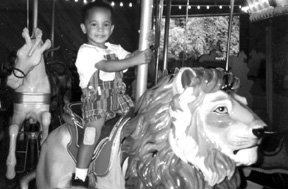
New rider David Floyd chooses the lion, at right.
Glen Echo Park's carousel is a Dentzel menagerie three-row park machine and dates from its installation there about 1921. The park has been managed by the National Park Service since 1971. The carousel was saved when a group of individuals organized a fund-raising campaign. Complete with its original Wurlitzer Military Organ, this Cadillac of carousels will get your toes tapping. Opens May 2 through Labor Day, Wed. and Thurs. from 10am to 2pm; weekends noon to 6pm; 50 cents a ride: 301/492-6282.
This two-row "county fair style" built by the U.S. Merry-Go-Round Company (circa 1890-1903), has been owned by All Hallow's Guild since 1963. On the National Historic Register, the menagerie received the "Historic Carousel Award" for 1997. It's used for special events and open for rides only during the annual Flower Mart, which this year was May 1 and 2: 202/537-2937.
An Allen Herschell four-row portable, dating from 1947 and a Wurlitzer band organ circa 1900s is open year-round. Daily 10am to 6pm, weather permitting; $1.25 a ride: 202/287-3620 x 167.
Manager Ron Postman calls this Herschell-Spillman three-row park machine dating to around 1910 a "Chevy," but proud nonetheless. This machine also spent some time on the Washington Mall. Acquired by Montgomery County in 1988 from Jim Wells, a local, avid carousel and amusement ride collector. Open April 25-June 21, Mon. to Fri. from 10am to 6pm; Sat. to Sun. 10 to 5; June 22-September 7, Mon. to Fri. from 10am to 5pm; Sat. to Sun. 10 to 6; $1 a ride: 301/946-7034.
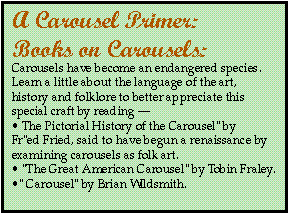
Carved by Herschell-Spillman, this 1906 two-row portable spent its first 45 years in upstate New York. When local Baltimore builder Richard Knight saw that carousels were being broken up and the animals sawn apart for sale, he bought the carousel and brought it to Baltimore. In 1979, he found a home for the 40-foot carousel in the newly opened Inner Harbor.
It's a smaller twin of the big 65-foot park machine at Trimper's in Ocean City. Each year, the animals are repainted by students at Hammond High School. Knight says the carousel needs a building to protect it from the elements. Any offers?
This is the carousel you saw in a March episode of Homicide as the scene from which a child was abducted.
Operates year round, weather permitting. 10am to 11pm whenever kids are out of school; $1 a ride: 410/964-0055.
A Herschell-Spillman menagerie three-row park machine, in continuous use since 1902. Its sister carousel at Coney Island burned. Open weekends all year; from Memorial Day to Labor Day weekdays 1 to 11pm and weekends noon to 11pm; $1.20 a ride: 410/289-8617.
| Back to Archives |
VolumeVI Number 19
May 14-20, 1998
New Bay Times
| Homepage |